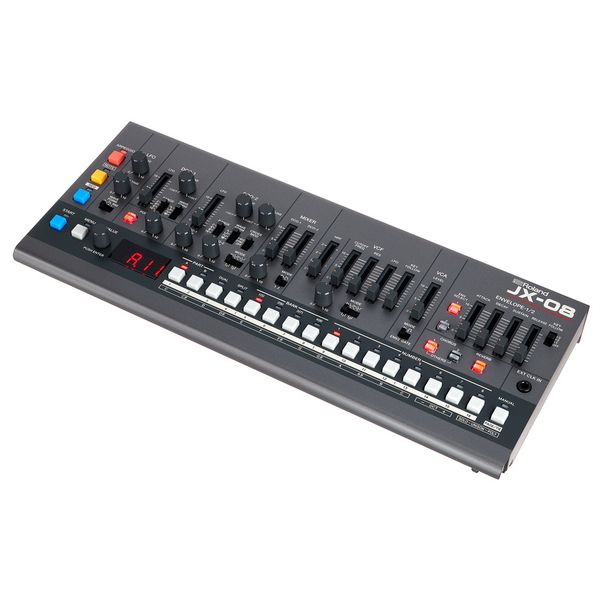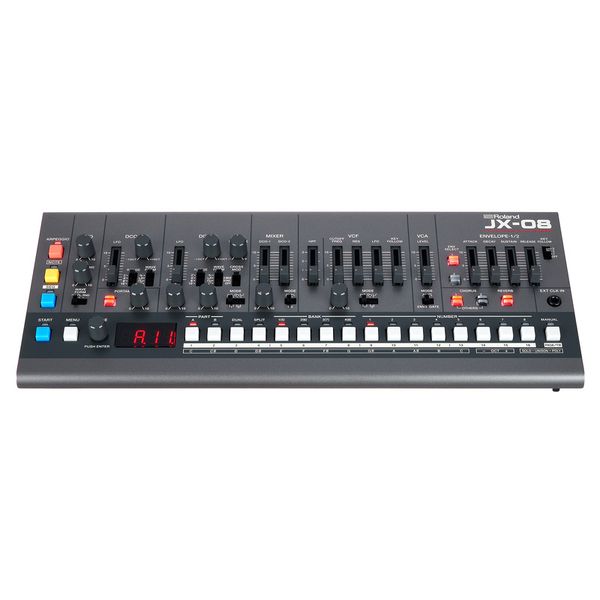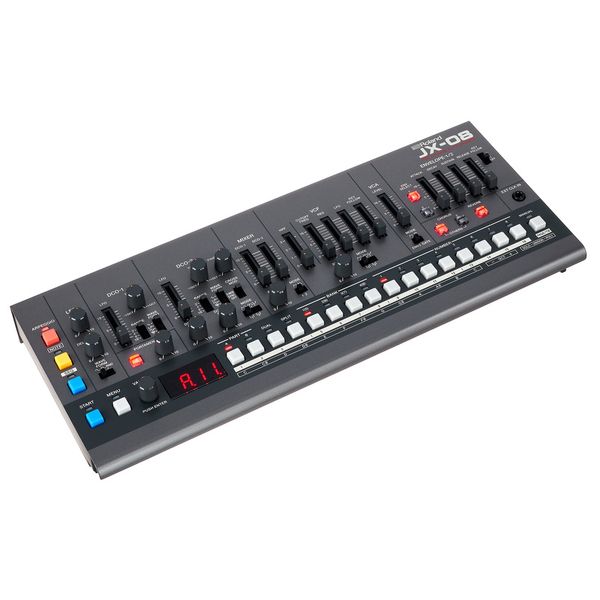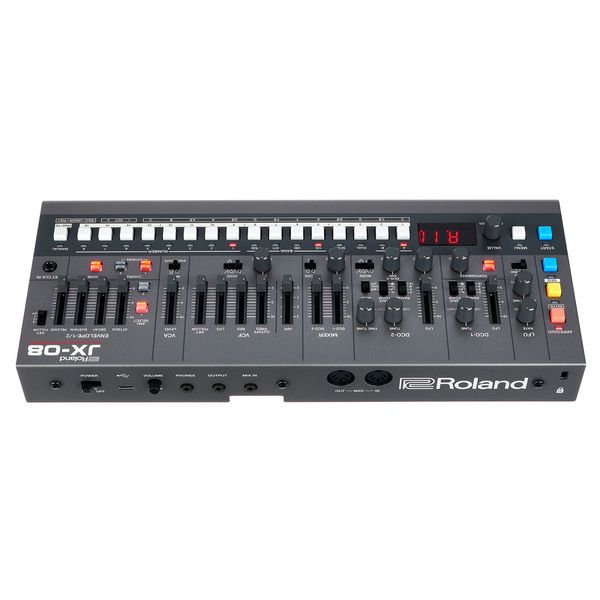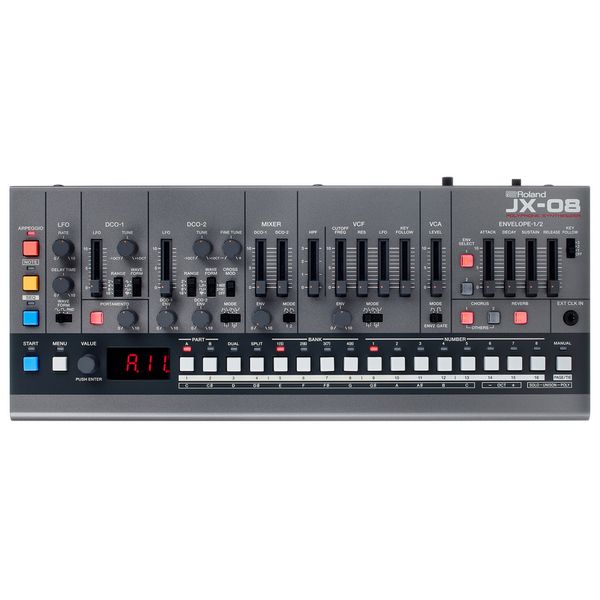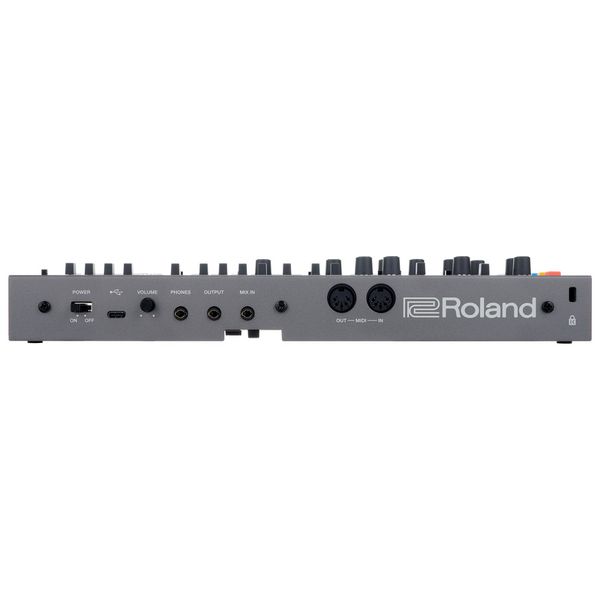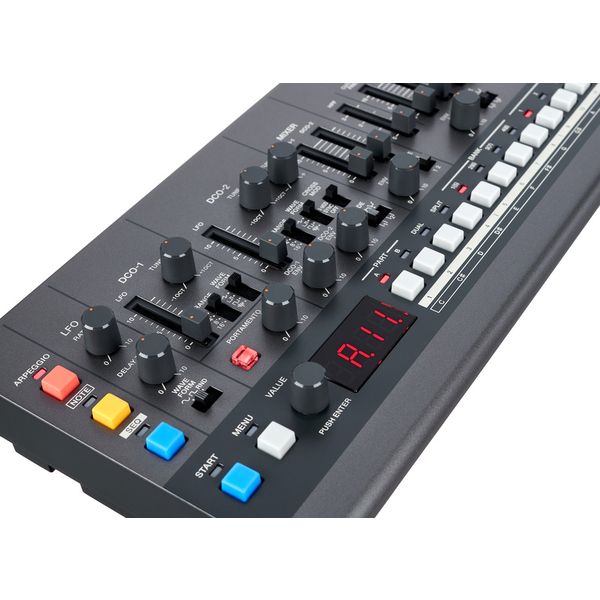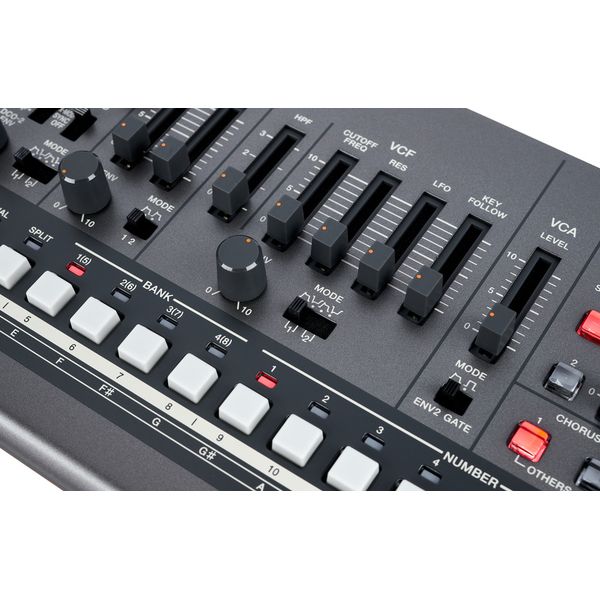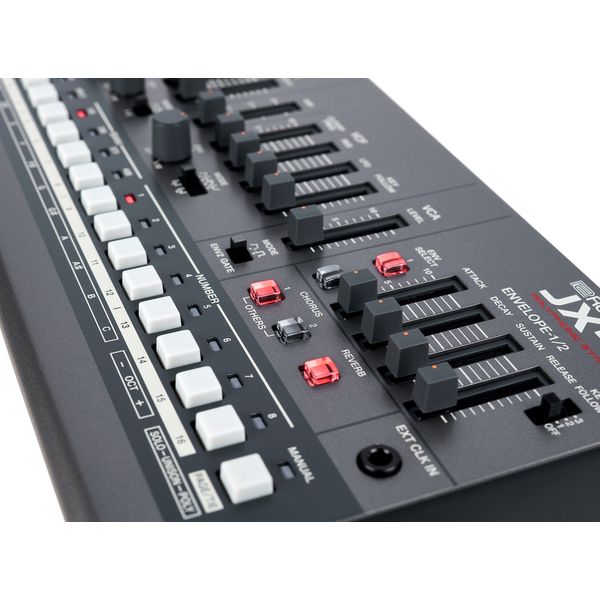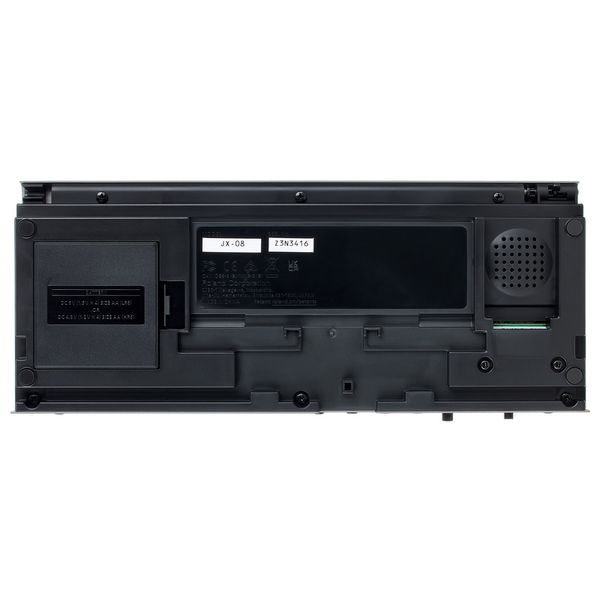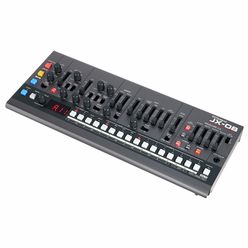Die Neugier war groß, und als Frühbesteller konnte ich kaum glauben, dass ich noch in 2021 beliefert würde..., somit herzlichen Dank an die Thomänner und Thofrauen.. :-)
Das Fazit gleich zu Beginn: Roland hat ein Top-Produkt abgeliefert und sich mit späteren Geräten der Linie 'Boutique" die Messlatte selbst deutlich höher gesetzt, und das für knapp 400 €. Doch schauen wir genauer hin und lassen die Euphorie beiseite, den VK-Preis aber stets im Hinterkopf behaltend.
Mission: Emulation des JX-8P und des PG-800, ein kühnes Vorhaben für die zu Grunde liegende ZEN-Core – Engine und den Formfaktor.
Dem JX-08 hört man tatsächlich das digitale Herz kaum an, und dies ist positiv zu verstehen, denn der Sound ist sehr nahe am Original, voll und warm; man erkennt das Vorbild, wenn es auch nicht zu 100% getroffen wird, nicht werden kann. Aber es zeigt sich, dass es Roland richtig gemacht hat, keine analogen Synthesizer mehr zu entwickeln und sich stattdessen auf digitale Replikationen und Novitäten zu fokussieren sowie nun endlich eine brauchbare Polyphonie abzuliefern (Boutique).
Das war das Stichwort: Warum aber noch immer so viel Mysterium um die Stimmenanzahl?
Weil die angeblich 20 Stimmen sicher nur ohne Effekte und insgesamt bestenfalls programmabhängig (Sequenzernutzung, Bi-Timbralität etc.) erreichbar sein dürften.
Da ist mehr Transparenz wünschenswert dazu, wann wieviele Stimmen erreicht werden können…, auch trotz bzw. wegen des günstigen Preises.
Ebenso bleibt die Hoffnung, dass die Roländer sehr bald ein gut gegliedertes Manual zum Download nachreichen werden, das man auch offline nutzen kann.
Zurück zum ‚kleinen Roland‘: Nach dem Auspacken fällt das angenehm vertrauenerweckende Gewicht und die Solidität der Maschine positiv auf. Die Tatsache, dass weiterhin DIN-5 - Anschlüsse für MIDI in/out vorhanden sind, ist ebenfalls sehr positiv zu bewerten.
Der Volume-Regler auf der Rückseite stellt ebensowenig ein Problem dar, wie der haptisch unschöne Powerschalter dort. Und das Update auf die aktuelle OS-Version ist simpel, wenn man mit PCs hantieren kann und USB nicht für das Schwesterunternehmen eines großen Logistikers hält, oder gar für eine Bank.
Zurück zur Oberfläche: Einige der Potis sind sogar leicht mittengerastet, wo sinnvoll (Tuning der Oszillatoren), und die Fader sind allesamt gut bedienbar.
Alles fühlt sich wertig an, ebenso haben die Tasten einen gut spürbaren Druckpunkt, und die schwarzen Schalterchen lassen sich einigermaßen präzise bedienen, ohne über das Ziel hinaus fehlbedient zu werden.
Zur Übersicht tragen auch die am Original angelehnte Farbgebung des Gehäuses und die zahlreichen LEDs bei, jedoch ist die Beschriftung auf der linken Seite gewöhnungsbedürftig hinsichtlich der Zuordnung zu den Tastern: Hier hätte ich mir eine bessere Ausnutzung des verfügbaren Platzes auf dem Gehäuse gewünscht. Auch bei dem restlichen Panel hätte es gut und gerne zwei Zentimeter mehr Raum gegeben – homogen dann mit der linken Seite-, davon hätte die Länge der Fader (die dann natürlich auch teurer geworden wären) sowie die Abstände zwischen den Bedienelementen insgesamt profitiert, aber hier ist wohl eher "function follows form" maßgeblich gewesen, zusammen mit Einsparungen bei den Fadern...
Insgesamt scheint mir dies alles verzeihbar, erinnert mich das im Hinterkopf Gespeicherte.
Überhaupt muss auch bei der folgenden Darstellung der Pros und Cons daran erinnert werden, dass das Gerät für ein unschlagbar günstiges Budget über den (virtuellen) Ladentisch wandert.
Da ist es dann auch verzeihbar, dass Roland nicht endlich die schon beim JX-8P fehlende Pulsweitenmodulation nachgeschoben hat. Auch ein zweiter LFO hätte dem Gerät gut zu Gesicht gestanden; da wäre mehr Mut gefragt gewesen, den man jedoch dann sicher bei der Ur-Version des ZEN-JX08, also der Softwareversion, schon hätte aufbringen müssen, hat man doch sicher die Engine 1:1 übernommen.
Das Ausdünnen des Sounds bei hoher Resonanz indes hätte man kompensieren können, digitale Filtermodelle sind seit langem eine Stärke der Rolandos, Yamaha hat es sogar mit dem QS300 (!) und anderen vorgemacht, dass hohe Resonanzwerte nicht unbedingt mit einem Einbruch der tiefen Frequenzen bzw. des Levels einher gehen müssen. Und: Wo ist die Sys-Ex – Kompatibilität? Bitte schnell ein Update, wenn man sich schon an Originale im eigenen Hause heranwagt. Unisono-Detune? Volle Cross-Mod – Power des Vorbildes? Sollte auch eine Agenda für ein Update sein.
Sound: Man erkennt ihn, den JX-8P. Kann man den Urvater zum alten Eisen nun rechnen? Sicher nicht, und – man ahnt das Gespeicherte vom Hinterkopf – nicht für 400 Eurönchen.
Dennoch klingt und fühlt sich alles schön rund, reichlich und gewichtig an, saubere Arbeit!
Pros:
-Digitaler Synth mit analogem, sattem und druckvollem Klang
-Bitimbralitätskonzept
-Polyphonie
-FX: Vielfalt und Qualität
-USB 2.0 Audiointerface
-Eingänge für externe Quellen
-zwei unabhängige polyphone (!) 64-Stepsequenzer
-Arpeggiator
-Umsetzung von Aftertouch und Dynamik
-Parameter-Recording für jeden Part
-Originalpresets & Onboard-Speicher für Sounds und Sequenzen
-Datenablage via USB
-Upgrade-Fähigkeit
-sehr niedriges Eigenrauschen
-Insgesamt recht authentische Reproduktion des JX-8P
-User Interface / Haptik
-Preis-Leistungsverhältnis
Cons:
-nicht optimale Ausnutzung der Bedienoberfläche
-Schwächen bei Cross-Modulation & Filter-Resonanzauswirkung auf VCA-Level
-Kein Wort vom Unisono-Detune: Geht es, oder nicht?
-aktuelle Situation bei der Bedienungsanleitung
-Intransparenz bei der Polyphonie und der Anzahl aufnehmbarer Parameter im Sequenzer
-Fehlen von PWM und zweitem LFO (zu relativieren)
Ansonsten: Klare Kaufempfehlung, denn der JX-08 ist zwar ein Kompromiss, aber ein Juwel in seiner Kategorie und für mich klar der überzeugendste Boutique-Vertreter bislang, wenn…, ja wenn man keine 1:1-Replikation des Originals erwartet. Aber – für diesen Preis – ist nahe dran oft schon nahe genug für Spaß und Freude – und das kann er sehr gut, der JX-08!





